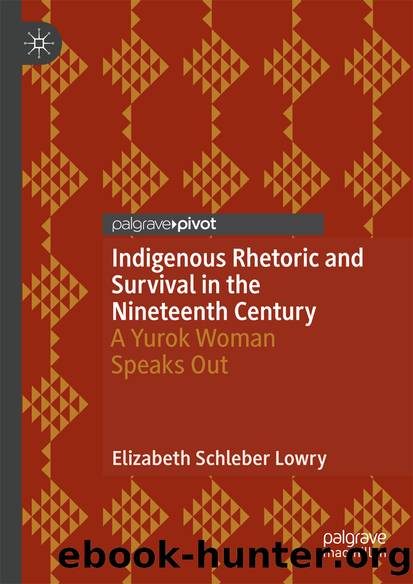Indigenous Rhetoric and Survival in the Nineteenth Century by Elizabeth Schleber Lowry

Author:Elizabeth Schleber Lowry
Language: eng
Format: epub
ISBN: 9783030002596
Publisher: Springer International Publishing
Keywords
LandscapeYurok religionSpiritual practiceBibleMythologyChristianity
“Cultural Brokers” and “Christianizing ”
As scholars of indigenous rhetoric have noted, Native rhetors have long been compelled to play the role of “cultural broker,” tasked with mediating between Euroamerican and Native cultures. 1 As a cultural broker, Thompson considered it her duty to convince white power elites that indigenous people were not an abstraction: they were real human beings who had suffered—and who continued to suffer—horribly as a result of colonialism . As Buckley puts it, Thompson was compelled to “restore the native peoples of northwestern California to the human race” which she did “largely by using non-Indian comparative mythology and symbolism.” 2 Buckley convincingly argues that Thompson’s references to Christianity and to masonry were a rhetorical strategy aimed to appeal to a sympathetic white reader. But what if the rhetorical function of Thompson’s retelling of Christian bible stories does something other than deliver what Buckley terms “apologetic transformations, or reinenvisionings”? What if Thompson’s work was also motivated by a desire to resist the fear “of being misunderstood by a powerful and still-dangerous white audience”? 3 There is no doubt that white audiences were indeed powerful and dangerous, but what if Thompson’s retellings of Christian narratives were refigured to be subversive, rather than conciliatory? I argue that rather than “Christianizing ” Yurok legends as her critics have suggested, 4 Thompson is perhaps “Yurokizing” or “indigenizing ” Christian legends. By indigenizing Christian mythology , Thompson encourages Natives to question Christian ideology. In doing so, she demonstrates that Christians have nothing to add to Yurok spiritual life because Yurok mythology and ritual practice are not lacking in any way.
In his work on the nineteenth-century rhetor Francis La Flesche, Ernest Stromberg discusses how, at “Indian Schools,” children were taught Christian bible stories that were intended to replace their own cultural stories. 5 In his autobiographical work, The Middle Five: Indian Schoolboys of the Omaha Tribe, La Flesche describes being taught the story of Adam and Eve in the Garden of Eden. Missionaries who worked with the children evidently assumed that they could simply be forced to accept the Christian narrative over their own Omaha origin stories. However, the story of Adam and Eve—in particular, Eve’s conversation with a serpent—seems absurd to the indigenous children who tease the boy tasked with recounting the story. Eventually, the boy abandons the Christian story and tells a creation myth from his own culture. Stromberg writes, “In this scenario, La Flesche has taken one of Western culture’s most sacred texts and rendered it comic…The boys’ laughter subverts the cultural authority of the Christian story; simultaneously La Flesche has brought the Christian narrative into intimate proximity with the Omaha story of the first woman, in effect bringing together what the missionaries strove to separate.” 6 As Stromberg explains, this is an example of La Flesche’s sophisticated use of irony . In formulating her own versions of Christian stories, Thompson performs a subversive rhetorical move, but she does not use humor as La Flesche does. Instead, the stories
Download
This site does not store any files on its server. We only index and link to content provided by other sites. Please contact the content providers to delete copyright contents if any and email us, we'll remove relevant links or contents immediately.
| Africa | Americas |
| Arctic & Antarctica | Asia |
| Australia & Oceania | Europe |
| Middle East | Russia |
| United States | World |
| Ancient Civilizations | Military |
| Historical Study & Educational Resources |
Cat's cradle by Kurt Vonnegut(14795)
Pimp by Iceberg Slim(13810)
Underground: A Human History of the Worlds Beneath Our Feet by Will Hunt(11850)
4 3 2 1: A Novel by Paul Auster(11824)
The Radium Girls by Kate Moore(11644)
Wiseguy by Nicholas Pileggi(5340)
American History Stories, Volume III (Yesterday's Classics) by Pratt Mara L(5142)
Perfect Rhythm by Jae(5085)
The Fire Next Time by James Baldwin(5034)
Paper Towns by Green John(4817)
Pale Blue Dot by Carl Sagan(4639)
A Higher Loyalty: Truth, Lies, and Leadership by James Comey(4569)
The Mayflower and the Pilgrims' New World by Nathaniel Philbrick(4289)
The Doomsday Machine by Daniel Ellsberg(4254)
Killers of the Flower Moon: The Osage Murders and the Birth of the FBI by David Grann(4200)
Too Much and Not the Mood by Durga Chew-Bose(4107)
The Sympathizer by Viet Thanh Nguyen(4101)
The Borden Murders by Sarah Miller(4033)
Sticky Fingers by Joe Hagan(3919)
